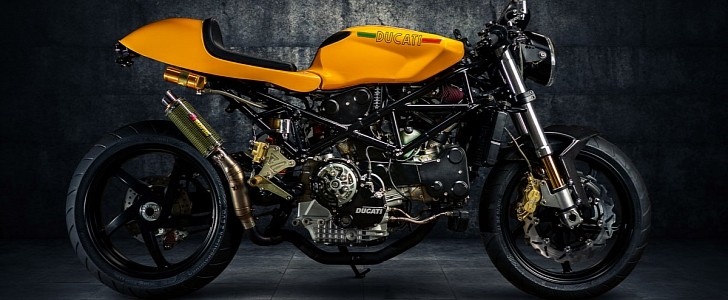Introduced in the late ‘90s as a replacement for the 907 Paso sport tourer, the ST series comprises five family members. The ST4S we’re going cover today isn’t your typical motorcycle, but a one-of-one customized to be lighter and noticeably different from the bone-stock model.
Based on a 2005 Ducati ST4S, the “Moto Motivo Calabrone” morphed into a naked bike with improved handling and braking. Speaking to Return of the Café Racers, founder Johann Keyser said that he started the build by removing pretty much every piece of bodywork and the fuel tank.
Sourced from a 999 superbike, the tank is complemented by a retro-styled tail as well as a modified subframe. Right in front of the rider, two gauges from the Monster SR4S are flanked by clip-on bars clipped on top of the fork legs. The V-rod headlight unit is joined by LEDs for the taillight, and as you can tell, the saddle is handcrafted to fit the new tail.
Painted in yellow and black, the one-off motorcycle further sweetens the deal with classically correct Ducati decals and Italian motifs like the stripes on the sides of the fuel tank and the decal out back. Translating to “hornet” in English, the Calabrone features a V-twin that breathes better than before thanks to K&N air filters and a ceramic-coated custom exhaust system. The carbon-fiber muffler from Akrapovic features yellow weave.
Re-flashing the Desmoquattro’s engine control unit and the Ducati Monster S4RS wiring loom have leveled up the performance too. Although the new numbers haven’t been published, it’s worth remembering that the 996-cc motor used to pump out 117 horsepower and 98 Nm (72 pound-feet) totally stock. Typical of an expensive Italian bike from this era, the transmission is a six-gear unit with a hydraulically operated multi-disc clutch.
“The braking and handling have also benefitted due to weight saving,” said Johann. The South African ex-pat understood what lightness means on two wheels when he was a professional rider sponsored by Fantic Motor, an Italian manufacturer of enduro bikes, founded in 1968.
Sourced from a 999 superbike, the tank is complemented by a retro-styled tail as well as a modified subframe. Right in front of the rider, two gauges from the Monster SR4S are flanked by clip-on bars clipped on top of the fork legs. The V-rod headlight unit is joined by LEDs for the taillight, and as you can tell, the saddle is handcrafted to fit the new tail.
Painted in yellow and black, the one-off motorcycle further sweetens the deal with classically correct Ducati decals and Italian motifs like the stripes on the sides of the fuel tank and the decal out back. Translating to “hornet” in English, the Calabrone features a V-twin that breathes better than before thanks to K&N air filters and a ceramic-coated custom exhaust system. The carbon-fiber muffler from Akrapovic features yellow weave.
Re-flashing the Desmoquattro’s engine control unit and the Ducati Monster S4RS wiring loom have leveled up the performance too. Although the new numbers haven’t been published, it’s worth remembering that the 996-cc motor used to pump out 117 horsepower and 98 Nm (72 pound-feet) totally stock. Typical of an expensive Italian bike from this era, the transmission is a six-gear unit with a hydraulically operated multi-disc clutch.
“The braking and handling have also benefitted due to weight saving,” said Johann. The South African ex-pat understood what lightness means on two wheels when he was a professional rider sponsored by Fantic Motor, an Italian manufacturer of enduro bikes, founded in 1968.









